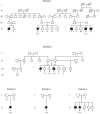Navajo neurohepatopathy is caused by a mutation in the MPV17 gene
- PMID: 16909392
- PMCID: PMC1559552
- DOI: 10.1086/506913
Navajo neurohepatopathy is caused by a mutation in the MPV17 gene
Abstract
Navajo neurohepatopathy (NNH) is an autosomal recessive disease that is prevalent among Navajo children in the southwestern United States. The major clinical features are hepatopathy, peripheral neuropathy, corneal anesthesia and scarring, acral mutilation, cerebral leukoencephalopathy, failure to thrive, and recurrent metabolic acidosis with intercurrent infections. Infantile, childhood, and classic forms of NNH have been described. Mitochondrial DNA (mtDNA) depletion was detected in the livers of two patients, suggesting a primary defect in mtDNA maintenance. Homozygosity mapping of two families with NNH suggested linkage to chromosome 2p24. This locus includes the MPV17 gene, which, when mutated, causes a hepatocerebral form of mtDNA depletion. Sequencing of the MPV17 gene in six patients with NNH from five families revealed the homozygous R50Q mutation described elsewhere. Identification of a single missense mutation in patients with NNH confirms that the disease is probably due to a founder effect and extends the phenotypic spectrum associated with MPV17 mutations.
Figures

Similar articles
-
Navajo neurohepatopathy: a mitochondrial DNA depletion syndrome?Hepatology. 2001 Jul;34(1):116-20. doi: 10.1053/jhep.2001.25921. Hepatology. 2001. PMID: 11431741
-
MPV17-related mitochondrial DNA maintenance defect: New cases and review of clinical, biochemical, and molecular aspects.Hum Mutat. 2018 Apr;39(4):461-470. doi: 10.1002/humu.23387. Epub 2018 Jan 13. Hum Mutat. 2018. PMID: 29282788
-
Navajo Neurohepatopathy : A Case Report and Literature Review Emphasizing Clinicopathologic Diagnosis.Acta Gastroenterol Belg. 2016 Sep-Dec;79(4):463-469. Acta Gastroenterol Belg. 2016. PMID: 28209105 Review.
-
MPV17-associated hepatocerebral mitochondrial DNA depletion syndrome: new patients and novel mutations.Mol Genet Metab. 2010 Mar;99(3):300-8. doi: 10.1016/j.ymgme.2009.10.003. Epub 2009 Oct 13. Mol Genet Metab. 2010. PMID: 20074988
-
Mitochondrial syndromes with leukoencephalopathies.Semin Neurol. 2012 Feb;32(1):55-61. doi: 10.1055/s-0032-1306387. Epub 2012 Mar 15. Semin Neurol. 2012. PMID: 22422207 Review.
Cited by
-
Hand involvement in Navajo neurohepatopathy: a case report.Hand (N Y). 2011 Jun;6(2):217-9. doi: 10.1007/s11552-010-9309-1. Epub 2010 Nov 19. Hand (N Y). 2011. PMID: 22654708 Free PMC article.
-
Metabolite transport across the peroxisomal membrane.Biochem J. 2007 Jan 15;401(2):365-75. doi: 10.1042/BJ20061352. Biochem J. 2007. PMID: 17173541 Free PMC article. Review.
-
MPV17-related hepatocerebral mitochondrial DNA depletion syndrome (MPV17-NNH) revisited.eNeurologicalSci. 2016 Jan 28;2:8-13. doi: 10.1016/j.ensci.2016.01.004. eCollection 2016 Mar. eNeurologicalSci. 2016. PMID: 29473055 Free PMC article.
-
Clinical, biochemical, cellular and molecular characterization of mitochondrial DNA depletion syndrome due to novel mutations in the MPV17 gene.Eur J Hum Genet. 2014 Feb;22(2):184-91. doi: 10.1038/ejhg.2013.112. Epub 2013 May 29. Eur J Hum Genet. 2014. PMID: 23714749 Free PMC article.
-
Hepatocerebral form of mitochondrial DNA depletion syndrome due to mutation in MPV17 gene.Saudi J Gastroenterol. 2012 Jul-Aug;18(4):285-9. doi: 10.4103/1319-3767.98439. Saudi J Gastroenterol. 2012. PMID: 22824774 Free PMC article.
References
Web Resource
-
- Online Mendelian Inheritance in Man (OMIM), http://www.ncbi.nlm.nih.gov/Omim (for NNH, DGUOK, TK2, SUCLA2, POLG, TFAM, NRF-1, ENDOG, MPV17, and Alpers syndrome)
References
-
- Appenzeller O, Kornfeld M, Snyder R (1976) Acromutilating, paralyzing neuropathy with corneal ulceration in Navajo children. Arch Neurol 33:733–738 - PubMed
Publication types
MeSH terms
Substances
Grants and funding
LinkOut - more resources
Full Text Sources
Medical
Molecular Biology Databases

